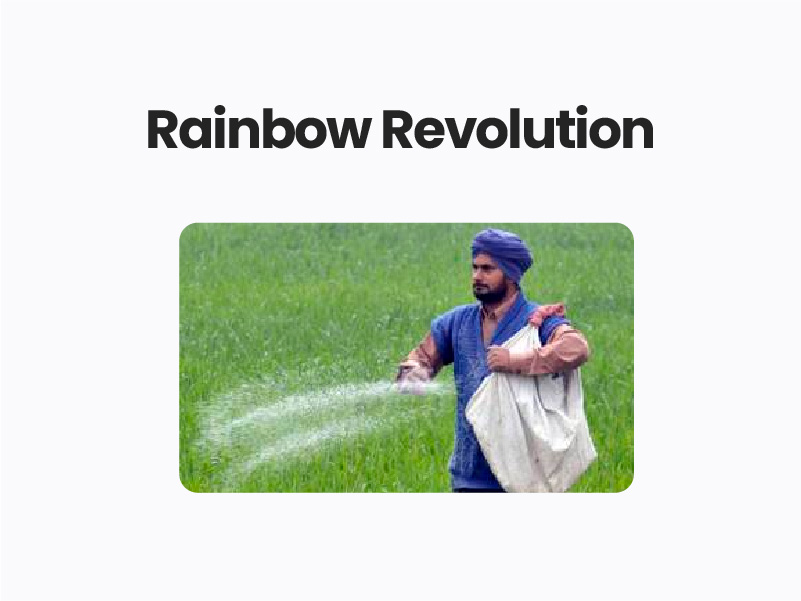Companion@360 → 7 Month programme to sharpen your writing skills → REGISTER NOW

Rainbow Revolution
The policy aimed at achieving a growth rate of over 4 per cent per annum by introducing `rainbow revolution’ in the next two decades so that the total GDP growth can be sustained at 6.5 per cent. In July 2000, the Centre Government of India had announced the first-ever national agriculture policy.
- The various colors of the Rainbow Revolution indicate various farm practices such as Green Revolution (Foodgrains), White Revolution (Milk), Yellow Revolution (Oil seeds), Blue Revolution (Fisheries); Golden Revolution (Fruits); Silver Revolution (Eggs), Round Revolution (Potato), Pink Revolution (Meat), Grey Revolution (Fertilizers) and so on. Thus, the concept of Rainbow revolution is an integrated development of crop cultivation, horticulture, forestry, fishery, poultry, animal husbandry and food processing industry.
Agricultural Scenario of Bihar:
- Bihar is the third largest state in India with respect to population and seventh largest in area. It supports 8.8 per cent of country’s population with only 2.8 per cent of land mass. Agriculture is an important sector since it generates 16 per cent of State GDP but provides employment to 70 per cent of rural working force.
- Climate of Bihar is favourable for production of various field crops but agriculture of the state seems to be less dependent on behaviour of monsoon and distribution of rainfall.
- The state has achieved almost sustainability in agricultural production because the food grain production was 162 lakh tonnesin the next year with only annual rainfall of 774 mm with only 34 rainy days.
- In Bihar, there was severe drought in 1966 when only 866 mm of monsoon rainfall was received and food grain production was declined by 50 per cent of the normal production level.
- An increase in food grain production in the state in drought years was made possible due to increase in number of private tube wells installed by farmers.
- However, the State Government also made some cosmetic efforts for maintaining agricultural production.
1. Green Revolution: M S Swaminathan is the founder of Green Revolution. It is one of the major revolutions in the field of agriculture in India which led to both economic and social changes. It generated employment for the people and increased the food grain production .This revolution has enabled people to use HYV variety of seeds .It has also allowed multiple cropping to take place.
2.White Revolution: Varghese Kurien is the founder of White Revolution. It was started by the Indian government for the sustainance of the dairy industry.The aim of this revolution is to make India self-sufficient in milk and other dairy products.It helped in increasing milk production and improving techniques for the same.
Which is the best UPSC Test Series Check Now
3.Yellow Revolution: Sam Pitroda is the founder of Yellow Revolution. It is started for the increase in oilseed production. It is the immediate rise in the production of edible oil due to the plantation of hybrid oil seeds like mustard,sesame etc.
4.Blue Revolution: Dr.Arun Krishnan is the founder of this Revolution. It is the step taken to cultivate the rising aquaculture in this modern age.It deals with the rising amount of fisheries and providing as well as maintaining the rightful amount of conditions for the growth and development of this sector of the society.
5.Golden Revolution: Nirpakh Tutej is the founder of this revolution. It mainly deals with the growth and development in honey production and the horticulture sector.This revolution helped the farmers to gain high profits with increase in the changing cropping patterns and construction of large farms.
6.SilverRevolution: Our former Prime minister Indira Gandhi is the founder of this Revolution.This deals with the increase in poultry farming and egg production.It has been able to meet the needs of the citizens successfully. The application of medical science and other technologies has allowed the development of this sector of agriculture.
7.Red Revolution: Vishal Tewari is the founder of this Revolution. It mainly deals with the cultivation and production of tomatoes and meat.This revolution has enabled the farmers to create a new era of cultivation.It is one of the recent types of revolution.
8.Black/Brown Revolution: This revolution speaks about the cultivation and large production of non-conventional sources of energy. Black Revolution deals with the production and world-wide distribution of petroleum and other related products.Brown revolution deals with the leather production.It is an aid for the clothes and textile industries.
9.Round Revolution: This revolution deals with the production of potatoes. It is one of the major parts of the Green Revolution.Due to the advancement in this sector, the whole agricultural sector has found a new boost.This revolution has paved its way to the increase in economic condition of the nation.
10.Grey Revolution: This revolution has brought massive changes in the whole agriculture sector.It deals with the application of fertilizers to the crops for better crop production. Fertilizers have brought a new change in the cultivation of crops.
Benefits of Rainbow Revolution:
- It keeps a check on the needs of the citizens and provide accordingly.
- It has been an aid for the production of the best products.
- It make better supply to the consumers.
- It’s a boon for the Indian agricultural and husbandry sector.
- It aims at increasing environmental sustainability as well as development of resources.
- It promotes organic farming to decrease the use of chemicals and fertilizers.
- It has made practices like rain water harvesting compulsory.
- It aims at improving soil testing techniques and other agricultural technologies.It promotes soil health schemes.
- It takes care of the income of the farmers. It keeps a check on annual growth in agricultural sector.
- It keeps the farmers informed about miscellaneous plans and programs of the government for their growth and development.
- It ensures proper market facilities for the farmers without any restrictions on the movement of products.
- It supplies the farmers with adequate number of go-downs and warehouses . It promotes the agricultural exports with the help of good quality of agri-products. It keeps on maintaining nutritional values of the products.
- Rainbow Revolution aims at interlinking all sectors of agriculture and husbandry for better efficiency of generating and producing crops and other products.
Free UPSC Prelims Mock Questions Free UPSC Mains Mock Questions
Energy for Rain bow revolution
Energy has a key role in economic and social development but there is a general lack of rural energy development policies that focus on agriculture. Agriculture has a dual role as an energy user and as an energy supplier in the form of bioenergy. This energy function of agriculture offers important rural development opportunities as well as one means of climate change mitigation by substituting bioenergy for fossil fuels.
Challenges for Rainbow Revolution
- Lack of Political Will
- Low level of seriousness among Officials
- Lack of Competent workers
- Small Size of Land Holdings
- Unorganized Marketing and Absence marketing Infrastructure
- Costly Irrigation
- Poor availability of seeds, particularly Pulses.vegetables and fruit saplings
- Fertilizer availability on reasonable prices
- Institutional credit declined during last three years and crop/livsestock insurance at very low level 10. Extension is still elite centricl.
Way Forward:
There is need for an innovation in agricultural marketing which is one of the major hindrance in fruit and vegetable production. Poor access of farmers to modern seeds of vegetables and fruit saplings needs improvement for increasing their production.
There is a need to create awareness among farmers about increasing production of various agricultural products but small size of land holdings, poor infrastructure and weak institutional arrangements should be considered for any agricultural development program



